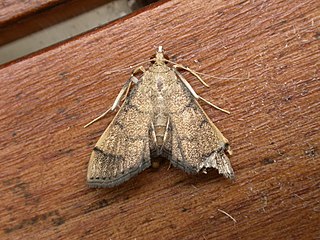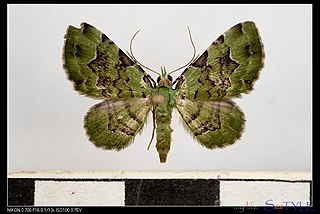
The flannel moths or crinkled flannel moths are a family of insects. They occur in North America and the New World tropics.

The Drepanidae are a family of moths with about 660 species described worldwide. They are generally divided in three subfamilies, which share the same type of hearing organ. Thyatirinae, previously often placed in their own family, bear a superficial resemblance to Noctuidae. Many species in the drepanid family have a distinctively hook-shaped apex to the fore wing, leading to their common name of hook-tips.

The Pyraloidea are a moth superfamily containing about 16,000 described species worldwide, and probably at least as many more remain to be described. They are generally fairly small moths, and as such, they have been traditionally associated with the paraphyletic Microlepidoptera.

The Limacodidae or Eucleidae are a family of moths in the superfamily Zygaenoidea or the Cossoidea; the placement is in dispute. They are often called slug moths because their caterpillars bear a distinct resemblance to slugs. They are also called cup moths because of the shape of their cocoons.

Callidulidae, the only known family of the superfamily Calliduloidea, is the family of Old World butterfly-moths, containing eight genera. They have a peculiar distribution, restricted to the Old World tropics of Southeast Asia to Australasia and Madagascar. The three subfamilies exhibit both day- and night-flying behaviour.

Casuariclystis is a genus of moths in the family Geometridae. It contains only one species, Casuariclystis latifascia, which is widespread. The range includes Borneo, the Andamans, Fiji, Rotuma Island, Vanuatu, New Caledonia, Hong Kong, the Ogasawara Islands, Kenya, Mauritius, Aldabra, and the Seychelles. The habitat consists of coastal areas, dry heath forests, limestone forests, oceanic islands, and dry secondary forests.

Herochroma baibarana is a species of moth of the family Geometridae first described by Shōnen Matsumura in 1931. It is found in China, Taiwan, Sri Lanka, the north-eastern parts of the Himalayas, Peninsular Malaysia, Sumatra and Borneo.
Chrysodeixis illuminata is a moth of the family Noctuidae. It is found across south-east Asia and the southern Pacific, including Fiji, Papua New Guinea, Timor, New Caledonia, Borneo, the Cook Islands, Queensland, the Chagos Archipelago and Samoa.

Asthenini is a tribe of geometer moths under subfamily Larentiinae first described by Warren in 1893. The tribe has been combined with Eupitheciini in the past, most notably by Jeremy Daniel Holloway in his work The Moths of Borneo.

Condica illecta is a moth of the family Noctuidae. It is found in both the Indo-Australian and Pacific tropics, including Borneo, Hawaii, Hong Kong, India, New Guinea, the Society Islands, Taiwan and Queensland and New South Wales in Australia. It is also present in New Zealand.
The Catephiini are a tribe of moths in the family Erebidae.

Omiodes indicata, the bean-leaf webworm moth or soybean leaf folder, is a species of moth of the family Crambidae. It is found from Florida to Texas, the West Indies and Mexico to South America, Cameroon, the Comoros, the Democratic Republic of Congo, La Réunion, Madagascar, Mauritius, Nigeria, Saudi Arabia, the Seychelles, South Africa, India, Borneo and Australia (Queensland).
Scopula hyphenophora is a moth of the family Geometridae. It is found in India, Peninsular Malaysia and on Borneo and Bali. The habitat consists of lowland primary and secondary forests, alluvial forests and forests on limestone.

Scopula mecysma is a moth of the family Geometridae first described by Charles Swinhoe in 1894. It is found in the Himalaya, Taiwan, Thailand and on Borneo, Java, Bali, Sulawesi and New Guinea. The habitat consists of lowland forests.

Ardonis filicata is a moth in the family Geometridae first described by Charles Swinhoe in 1892. It is found in the north-eastern Himalayas and Borneo and Sulawesi.
Celaenaclystis telygeta is a moth in the family Geometridae. It is found on Borneo.
Cyclophora glomerata is a moth in the family Geometridae. It is found in New Guinea and on Seram, Borneo and Sulawesi.

Didiguides is a monotypic moth genus of the family Nolidae erected by Lutz W. R. Kobes in 1994. Its only species, Didiguides semifervens, was first described by Francis Walker in 1863. It is found on Borneo, Sumatra and Sulawesi, as well as in New Guinea and on the Bismarck Islands. The habitat consists of dipterocarp forests, including alluvial forests.
The Hulodini are a tribe of moths in the family Erebidae.

The Sypnini are a tribe of moths in the family Erebidae.













